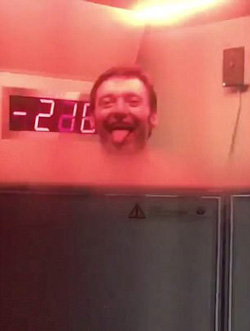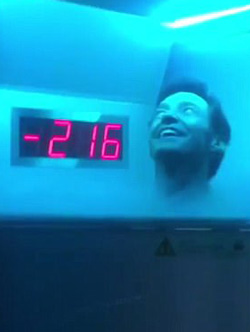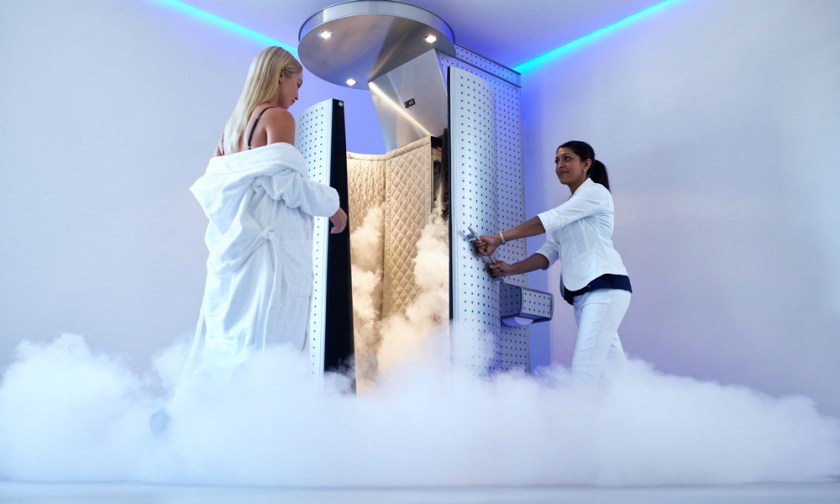The secret to Hugh Jackman’s superhuman physique at age 48 (one of them, at least – let’s not forget the gruelling gym workouts!) has been revealed – standing in a freezing tank for up to three minutes at a time, exposing his body to a temperature hovering around -130°C.
It might sounds nuts, but the anti-ageing and health benefits of extreme cold have been known for centuries in Nordic and Eastern European countries.
Athletes have long submerged themselves in baths of ice or used ice packs for recovery and to help numb pain.
And, of course, those who perform or assist with cosmetic medical procedures such as as injectables (that can, and often do, cause short term swelling and/or bruising) know to “ice” patients with various forms of cold packs before, during and after said procedures to prevent and/or minimise such occurrences. Further, to encourage patients to continue this at home in the immediate recovery period for the same reasons.
These principles were harnessed as a treatment known as cryotherapy – the term comes from the Greek that roughly translates as “cold cure” – originally developed in Japan in 1978 for relief of rheumatoid arthritis.


Cryotherapy was subsequently embraced for other medical purposes, for instance to: help athletes recover and improve their performance, to prevent relapses for different illnesses and in the treatment of muscular and inflammatory pathologies.
But in the last few years, medical cryotherapy (which uses cryogenic nitrogen vapour to create the way-sub-zero climate) has been repurposed yet again as a restorative and therapeutic treatment used not only for managing pain, but smoothing skin and cellulite, encouraging weight loss – even encouraging hair growth.
Studies have shown extreme cold can stimulate the body into burning up fat deposits and some manufacturers claim the tanks can chew though up to 800 calories in just three minutes.
Celebrities like Hugh Jackman – who posted his cryotherapy experience recently on Instagram (pictured above) – Jennifer Aniston, Jessica Alba, Demi Moore, Mandy Moore and Alicia Keys have been enthusiastic advocates of freezing their butts off (in the literal sense, it could be said), paving the way for a new wellness trend boom.

Sydney super-publicist Roxy Jacenko also recently added cryotherapy into her fitness routine (above), saying she spends up to two minutes inside a chamber every other day.
The Sweaty Betty PR founder, 36, has claimed she noticed an increase in her energy levels since beginning treatment.
Koa Sports Recovery and Wellness Centre, which opened for business in Sydney’s Waterloo in February, features a cryotherapy tank as a key component of its treatment menu.
Koa founder Shaun Button has worked in the health and fitness industry for over 10 years with a variety of client groups – for instance, at a major trauma hospital in rehabilitation for conditions including spinal cord injury, stroke, hip and knee replacements, arthritis and cardiac conditions.
He has also worked in gyms as a personal trainer, run outdoor boot camps and corporate health programs, and with the NSW Wheelchair Rugby Team as their strength and conditioning coach.
After some years living and working in the US he modelled Koa on similar, leading centres there. As Shaun describes: “Koa is a place of functional zen, promoting recovery and relaxation in an incredibly practical use of clinical space.
“We use leading manufacturers of cryo-saunas and other recovery tech in the US, mimicking many of the best practices that have attracted the likes of leading international athletes including Tom Brady, Michael Phelps, Usain Bolt, Stephen Curry and Simone Biles.
“These therapies we offer [at Koa] are widely used in the US for their health and beauty benefits and have been recognised multiple times in magazines such as Vogue and are used by celebrities including Yolanda and Gigi Hadid, Elle Macpherson, Kristen Wiig, Mandy Moore, Alicia Keys, Jessica Alba, Kate Moss and Jennifer Aniston.”
According to Shaun, cryotherapy increases the body’s ability to train, recover and perform at its optimal level, as well as:
- Reduce recovery time by 50%
- Reduce delayed onset muscle soreness
- Increase athletic performance
- Reduce swelling
- Enhances the body’s natural ability to heal itself
- Improves relaxation and decreases stress • Assists in managing chronic pain
- Helps decrease symptoms of depression, anxiety and fatigue
- Boosts energy
- Boosts metabolism
For beauty and anti-ageing, he says it helps:
- Skin to be fresher, tighter, younger, brighter and healthier
- Reduce cellulite
- Stimulate weight loss

Rugby Sevens player Nick Malouf (above) recently reviewed his Koa cryotherapy experience for Rogue Homme modern men’s online lifestyle magazine/blog:
“I have to admit, when I found out that cryotherapy involved getting into a chamber where the temperature was near on -130°C I was a little worried. After all, I struggle to stay in a 14°c ice bath for very long! Turns out I had nothing to worry about.
“Being a professional athlete I get plenty of kms in the legs, lifts in the gym and knocks on the body on a weekly basis with the game being one of the more brutal sports around.
“It was a Thursday and I had just come off the back of a big start to the week and my body and mind were exhausted. I desperately needed something to kick me back into gear.
“I was lucky enough to be invited down to the fantastic facilities at Koa Recovery.
“I stripped down to my budgies, slipped on my socks and gloves and entered the cryo chamber to begin my three minutes in the freezing cold mist.
“As I poked my head out of the top of the chamber, I could instantly feel the hairs start to stand up on my arms and legs as Shaun mentioned that the temperature on the chamber was sitting at about -100°C and dropping fast.
“As the seconds passed the chill moved deeper inside me, Shaun kept checking I was okay, but I was very comfortable.
“Actually I was enjoying the experience – it made me feel alive in a way that I hadn’t experienced before.
“I stepped out of the chamber and felt it immediately: blood rushing through my body, making me energized and alert. It didn’t just last for a few minutes either; it was a long-lasting natural high!”
According to Rex Sharp, the US University of Missouri’s associate athletic director for sports medicine, his athletes use the tank primarily for recovery after workouts.
‘When you get into an area of cold, the blood vessels on the skin shut down and the blood returns to the core,” he says.
“In the core the blood is reoxygenated. When you step into warmer weather, that blood rushes back out. You just feel invigorated, refreshed.’
He explains that the tanks’ freezing temperatures help boost blood circulation, which clears toxins such as lactic acid from the body.
This process helps both muscle and skin regeneration, making it a perfect therapy for recovering athletes – indeed anyone who needs a good post-workout recovery!




